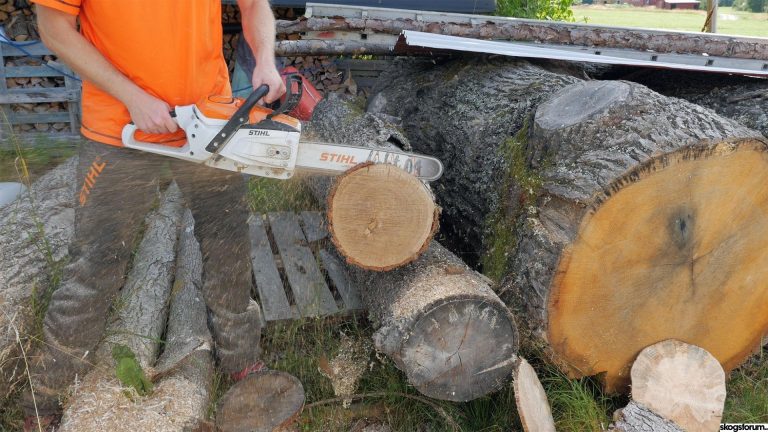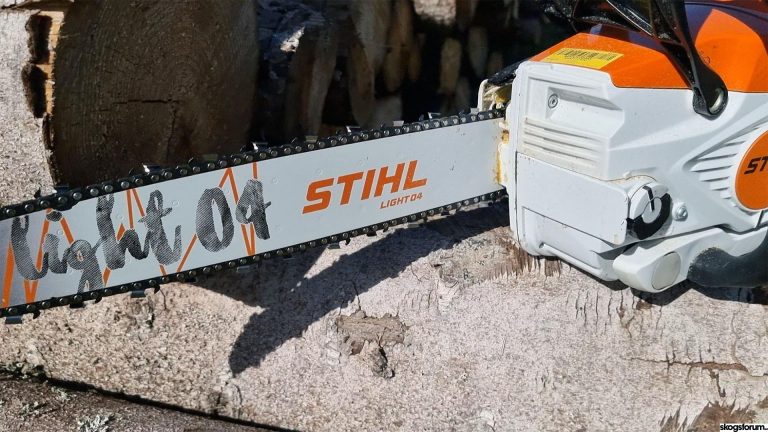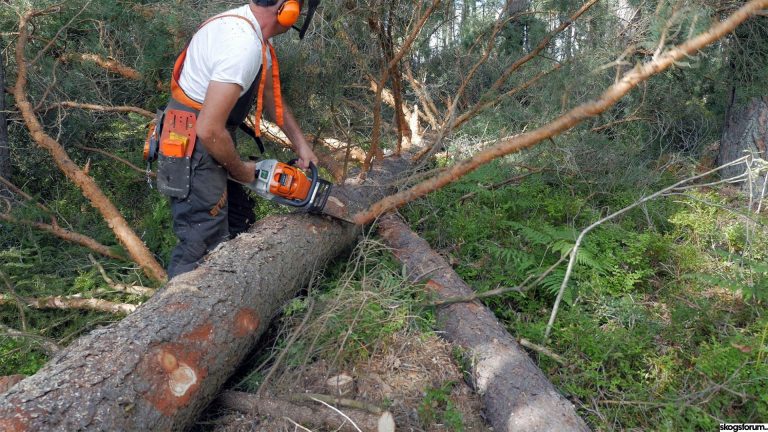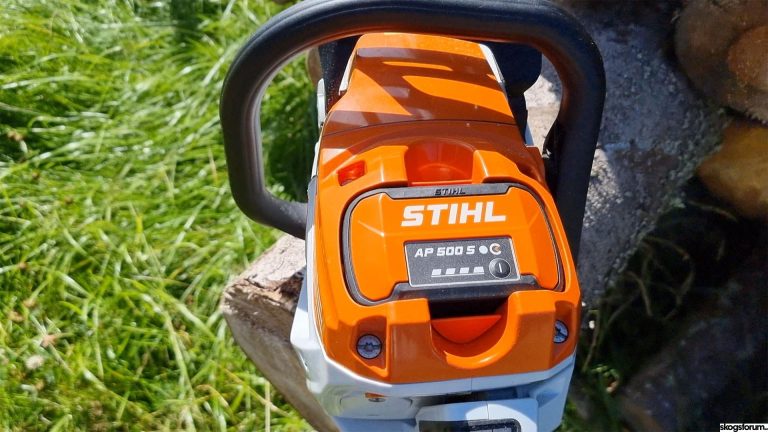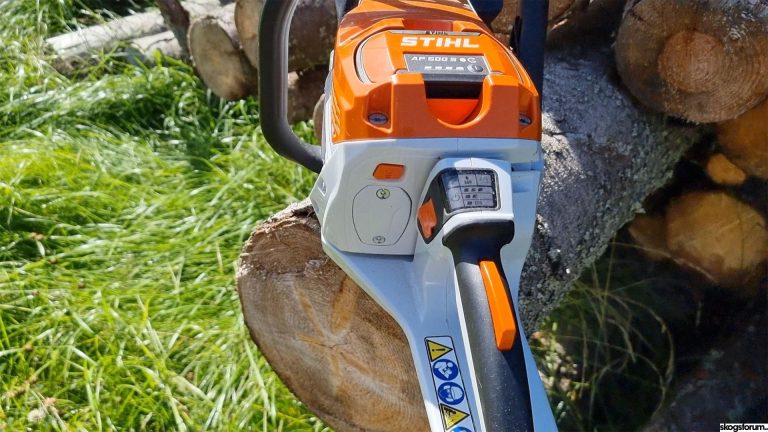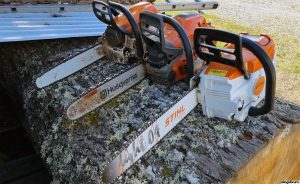The sister-site Skogsforum.se got the opportunity to test a Stihl MSA 300 C-O and compare it to a Stihl MS 261 and a Husqvarna 550 XP Mark II. The Stihl MSA 300 C-O is the first professional battery-powered chainsaw from Stihl. The effect is 3,0 kW. The professional logger Lars-Erik Larsson was the test pilot. Here are his impressions and a cookie-cutting test made by Skogsforum’s Fredrik Reuter who also wrote the original article in Swedish.
Stihl MSA 300 C-O battery saw
Theoretically, the MSA 300 C-O is comparable with the classic Stihl MS 261. Different tests were made to make the comparison as accurate as possible. One thing seems however obvious – that the Stihl MSA 300 C-O is at the top level among powerful battery saws in 2022.
The importance of the right cutting equipment
With the arrival of the battery saws, the importance of cutting equipment (chain and guide bar) has become more relevant. Maybe that’s due to that it’s easier to assess the power on electrical motors than on comparable gas motors. In addition to that, we also know the exact power of the batteries.
When smaller battery saws were tested, e.g., the Stihl MSA 220 there was a striking difference between different cutting equipment. It was also striking how the manufacturers optimize the power to a specific cutting system.
For the MSA 300, Stihl has chosen the proven Light04 system. It’s the same system that is recommended for the Stihl MS 261, with a 0,325” pitch chain and 1,3-millimeter gauge. The chain used during this test was an RS PRO. The test saw we received from Stihl had a 14” Light04 bar.
The assessment after the test is that the combination MSA 300 and Light04 was very good. The experience made, was that the RC PRO chain is relatively forgiving with little tendencies of kickbacks but still a good cutting capacity. The conclusion is that the Light04 bar with an RS PRO chain is a suitable cutting system for the Stihl MSA 300.
For whom is the Stihl MSA 300 suitable?
Which is the largest target group for a powerful battery saw, comparable with a 50-cc gas-powered saw? There are for sure forest owners who will like it. Loggers who work close to home and maybe not so long days. Older people who want an easy start function. Then, of course, there are always technology nerds who absolutely want “the latest”.
The Stihl MSA 300 C-O will most likely not be found among professional, full-time loggers, yet. But as an all-around saw, always close by on an ATV or the tractor. A handy saw for miscellaneous jobs on the farm etc.
Apart from arborists, there will probably be another target group for the MSA 300 among professional, manual loggers. Those who specialized in working in cities, gardens, and other populated areas. Here the silent battery saw will be appreciated.
However, the MSA 300 receives tough internal competition from the smaller MSA 220 which is also battery-powered. The power of the MSA 300 is not always needed in thinning and the MSA 220 is both lighter and smoother.
The downside with the MSA 220 is the throttle trigger lockout that must be pushed by the thumb on that model. Something that could be difficult to get used to.
The importance of the weight
The weight of the Stihl MSA 300 in the “RFF-test” (Ready For the Forest) is 7,6 kg (16,7 lbs.) with a 14” Light04 bar. Without a battery, the weight is 5,65 kg (12,46 lbs.). This should be compared to the Stihl MS 261 which weighs 6,45 kg (14,22 lbs.), and the Husky 550 XP Mrk II which weighs 7 kg (15,43 lbs.).
The battery saw weighs 1,15 respectively 0,6 kg more than the corresponding gas saws in this test. That may seem like a big difference but it’s up to everyone to judge. The test logger, in this case, Lars-Erik, didn’t react to that at all. Compared to the Stihl MSA 220, the MSA 300 weighs approx. 40 percent more.
The AP 500 S battery
Almost simultaneously with the MSA 300, Stihl also launched a new battery called AP 500 S. If you wish to utilize the full capacity of the MSA 300 you will need the AP 500 S battery. This battery is a development of the AP 300 S battery which means it has an effect of 36 V and has the same dimensions and connections as the AP 300 S battery. The difference is that the new AP 500 S has a new type of cells. Something that, according to Stihl, gives more power even though the dimensions are the same as for the predecessor. Also, the AP 500 S battery should withstand more charging cycles than the AP 300 S battery.
The AP 500 S battery has a max energy content of 337 Wh compared to the AP 300 S which has 281 Wh – approx. 20 percent more. Furthermore, the new Stihl battery matches Husky’s BLi 300 battery which also has 36 V and 337 Wh energy content.
Design and technology MSA 300
The saw that we received from Stihl was a demo sample. Probably from a pre-series from the factory in Germany. It should however be the same saw that will go into serial production. That could explain the high quality of the MSA 300, it seems to be at the same level as in all professional Stihl saws.
One, positive, difference compared to the Stihl MSA 220 is that the throttle trigger lockout is placed as on normal chainsaws, at the top of the rear handle, instead of on the (thumb-) side as on the MSA 220. Ergonomically, the MSA 300 is longer than the MSA 220 and feels bigger. The balancing is however good and the test operator, Lars-Erik, had no complaints.
Can the MSA 300 compete with the gas saws?
The short answer is: Yes, the MSA 300 can compete with both Stihl MS 261 and Husky 550 XP Mrk II. The cookie-cutting tests showed that the saws compared were similar in efficiency. To make the comparison as fair as possible, the gas saws were filled up with Aspen fuel from the same can. The MSA 300 was “filled” with fossil-free electricity. All three saws were filled with chain oil from the same can.
The saw chains on the Stihl MSA 300 and the Husky 550 XP were brand new, and the chain on the Stihl MS 261 had been used just a little bit. As you can see in the video below, all tests were made in the same logs.
Unfortunately, the Husky 550 XP broke down during the test. It was an older saw belonging to someone on the test team and obviously needed service. It started cold but refused to start when it was warm.
You can see the result of the cookie-cutting test in the chart below.
| Cut No (species) | Time sec MSA 300 | Time sec 550 XP Mrk II | Time sec MS 261 |
|---|---|---|---|
| 1 (Spruce) | 4,43 | 5,19 | 5,09 |
| 2 (Spruce) | 4,43 | 4,56 | 4,08 |
| 3 (Spruce) | 4,35 | - | - |
| 4 (Spruce | 4,15 | - | 3,47 |
| 5 (Spruce) | 3,21 | - | 3,41 |
| 6 (Oak) | 4,52 | - | 4,22 |
| 7 (Oak) | 4,41 | - | 4,04 |
| Average | 4,21 | 4,88 | 4,05 |
In the forest
In the forest, where the MSA 300 also was tested and compared, the result was similar. The conclusion is that the MSA 300 can compete with the gas saws also in felling, delimbing, and bucking. This is of course a subjective assessment. In the video below you will see Lars-Erik working with both smaller and larger trees. So, you can form your own opinion by watching that.
The battery
According to Stihl, the MSA 300 can generate a max 3 kW effect with a max chain speed of 30 m/s (meters per second). It’s impressive and proved in our test by the fact that it keeps up with the other two saws in the test.
We pushed the MSA 300 in the different power modes during the cookie-cutting test. Stihl seems to have succeeded with the transmission as the saw wasn’t overheated even once during the testing. The air temperature during the tests was approx. 18 degrees centigrade (64o F).
The battery turned hot, but the saw kept running. It’s a challenge to deliver a lot of energy quickly from a battery, something that Stihl seems to manage. Here it should be mentioned that intensive cookie-cutting, as in this case, is not a normal everyday routine for a chainsaw.
Charging and consumption
Once, after very intensive cookie-cutting at the highest power mode, we had to wait a moment until the battery charger decided that the battery temperature was low enough for a re-charging. Apart from this time, everything worked fine, and the charging time was approx. 35 minutes.
As for power consumption, 45 “cookies” could be cut at max power mode and 65 in ECO mode. The average log diameter was 20 centimeters (7,9 in). This means that the Stihl MSA 300 performs as expected compared to our previous test of the Husky 540i, Stihl MSA 220, and the Echo DCS 1600.
In the forest, our subjective assessment is that the running time for the MSA 300 at work as in the video below, is comparable to a gas tank on a comparable gas-powered saw. In other words, you must bring enough batteries to the forest. How many you must have, is due to how many hours you work and what power mode you use on the saw. If you use the ECO mode, you will need fewer batteries but then the MSA 300 will not be comparable to a 50-cc gas saw.
Economy
To compare battery power to gas power on chainsaws engages. The discussion divides the logging community into two sides. Either you hate the battery saw or you love it. Combining the two options due to the type of work seems to be no option.
The battery saw is expensive to buy. But then you must bear in mind that you buy a system that corresponds to the gas saws’ total gas consumption over a life cycle all at once. Economically you must do your calculation based on the saw’s life cycle.
The prices mentioned in Fredrik’s original article are all in SEK (Swedish Krona) and valid for Sweden. So, I will let the prices out here and focus on what’s needed. The reader then must find out and compare the costs “at home”.
The price for the saw excl. battery or gas is about the same. Also, the wear on guide bars and chains, and chain oil consumption are the same. So, these don’t have to be mentioned in the economical comparison.
Our test shows that a fully charged AP 500 S battery in a Stihl MSA 300, lasts approx. the same time as a gas tank on a Stihl MS 261. Let’s say that you normally use six tanks a day in the forest, that’s 3 liters of gas (0,8 US gallons). That means that you will need six batteries and six chargers (for overnight charging).
Costs for batteries, chargers, and gas must be considered. Also, how much you’re going to use the saw is an important factor. How many hours per day and how many years?
I mentioned above that I wouldn’t mention any cost figures here, but I will make one exception just to give an example. But this is based on Sweden and Swedish prices.
According to Fredrik’s calculation for a full-time logger using a chainsaw for three years, the battery saw (Stihl MSA 300) will be approx. 100 US dollars cheaper per month compared to the corresponding gas saw (Stihl MS 261).
Considering this, a company with many chainsaws in its fleet can save a lot of money on electricity. But, again, this is based on Swedish prices and conditions. Both gas- and electricity prices vary a lot between countries.
Summary
There is no doubt that the development of battery saws is going fast. The Stihl MSA 300, just like the Husky 540i, keeps up with professional gas saws in the 50-cc class. It feels like it’s only a matter of time until the battery saws take over.
Our test logger, Lars-Erik, liked the MSA 300 during the test where he felled trees in different sizes. The test was made in an area of summer houses. Some inhabitants of the area commented on the fact the saw was silent which proves that it’s a suitable saw for work in populated areas.
It takes some time to get used to the special features of a battery saw. E.g., the safety function on the MSA 300 turn the saw off when it has been stationary for a while. Then you must activate the saw again by pushing a button. No big deal and something you learn quite fast.
A slightly bigger problem, for an experienced logger like Lars-Erik, was that he repeatedly reached for the starter grip that wasn’t there. The “audience” found that quite amusing.
It’s a bit unclear when the Stihl MSA 300 will reach the market. I guess it will be different in different countries. You simply must keep a lookout at your local dealer’s.
Here is an article I wrote earlier about the Stihl MSA 300.
And here is a video from the test:
Photos: Fredrik Reuter






